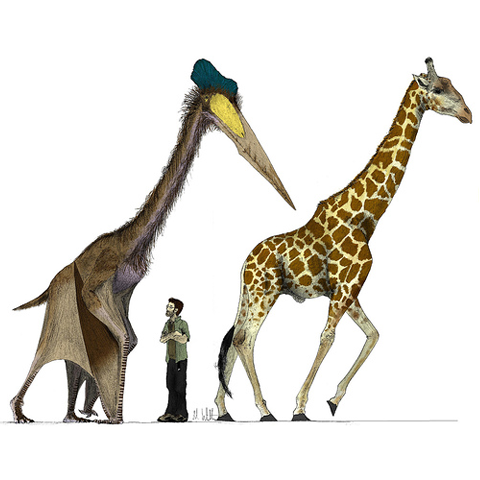Science news

27-May-2008 20:00 Eastern US Time
Giant flying reptiles liked to walk

The largest animal that ever flew was a kind of pterosaur called an azhdarchid. But these flying flesh-eaters from the age of the dinosaur spent as much time walking around on their hind legs as soaring in the sky.
Azhdarchids caught their prey by bending down to grab it with their enormous bills, say scientists at Portsmouth University. It's a novel theory, but Mark Witton and Dr Darren Naish have the evidence to back it up, they say.
Until recently pterosaurs were thought to have lived like modern seabirds such as gulls or pelicans. Perhaps they skimmed the surface, like the members of the Rynchops family today. But they certainly grabbed their prey from the waters of lakes and oceans.
What did they eat - and how?
But the young Portsmouth palaeontologists have now carried out a study of azhdarchid fossils that shows that some of the beasts at least were well adapted to life on land. The research is published today in PLoS ONE.
Azhdarchids first became well known to science in the 1970s, says Naish. "But how they lived has been the subject of much debate."
At first they were thought to be scavengers like vultures, he says. "But they were later suggested to be mud-probers - sticking their long bills into the ground in search of prey - and later still suggested to make a living by flying over the water’s surface, grabbing fish."
Other lifestyles had been suggested. "These all seem radically divergent so Mark and I sat down and carefully examined the evidence."
Getting back to the bones
They studied fossils in London, Portsmouth and Germany to compare the anatomy of azhdarchid with those of modern animals. This showed that azhdarchids were very different from mud-probers. Nor were they like those modern animals that grab their prey from the water’s surface while flying.
The study showed instead that "azhdarchids were specialised terrestrial stalkers," says Naish. "All the details of their anatomy, and the environment their fossils are found in, show that they made their living by walking around, reaching down to grab and pick up animals and other prey.”
Azhdarchids were better than other pterosaurs at walking, say Witon and Naish, because they had long limbs and skulls well suited for picking up animals and other food from the ground.
The evidence stacks up
The scientists looked in particular at what the bones showed about how the neck could move. "We worked out the range of motion possible in the azhdarchid neck," says Naish. "This bizarrely stiff neck has been a problem for other ideas about azhdarchid lifestyle. But it fits with our model. All a terrestrial stalker needs to do is raise and lower its bill tip to the ground.”
Over 50% of azhdarchid fossils come from sediments that were laid down inland, they discovered. The only articulated azhdarchid fossils found so far come from these inland sediments.
Animals like azhdarchids no longer exist. The closest to them in the modern world are large ground-feeding birds like ground-hornbills and storks. Azhdarchids include the largest of all pterosaurs. Some had a wingspan more than 10 metres across. The biggest of them all, known as Quetzalcoatlus, was as tall as a giraffe.
Terrifying terrestrial stalkers
Other aspects of azhdarchid anatomy, besides their neck, don't fit well with the lifestyles that had been suggested. But they fit perfectly with the terrestrial stalker hypothesis. They have relatively small padded feet, for instance. “The small feet of azhdarchids were no good for wading around lake margins or swimming should they land on water," says Witton. "But they are excellent for strutting around on land.
And what exactly would these terrifying terrestrial stalkers have grabbed with their long beaks, if this new theory is correct?
"They would have snapped up bite-size animals or even bits of fruit," says Witton. "But if your skull is over two metres in length then bite-size includes everything up to a dinosaur the size of a fox.”
Citation: Witton MP, Naish D (2008) A Reappraisal of Azhdarchid Pterosaur Functional Morphology and Paleoecology. PLoS ONE 3(5): e2271. doi:10.1371/journal.pone.0002271
More help with words
| breed | Cretaceous | dominant | environment | evolution | extinct |
| fertile | fossils | hypothesis | Jurassic | reptiles | |
| stalker | species | suspension | tentative |
What's it all about?
- The largest animal that ever flew on Earth was a kind of what?
- What did they eat?
- According to this new research how did azhdarchids catch their prey?
- Where do the scientists work?
- Before this new research, where did experts on pterosaurs believe they grabbed their prey?
- What did the Portsmouth palaeontologists actually study?
- When azhdarchid were first known about, scientists believed they ate like which modern type of bird?
- What do these modern birds eat? (Hint: move up the page a few lines, after following the link, so you can see the pop-up definition.)
- Before this latest research there were at least three different theories about how azhdarchids fed. State one of them.
- What did the scientists study besides azhdarchid fossil bones?
- This showed that azhdarchid anatomy was different from birds that did what?
- The scientists call the azhdarchids "specialised terrestrial stalkers". Which of the three pop-up meanings for the word "specialised" is meant here?
- The azhdarchid anatomy was well suited for walking and for what else?
- What is unusual about the azhdarchid neck?
- How does that fit with the scientists' new theory?
- How does where azhdarchid fossils have been found help to support the new theory?
- State one more piece of evidence that supports it.
- This new research does not prove that azhdarchid were "terrifying terrestrial stalkers". What does it do?
- If you worked with Mark and Darren what would you like to do next?

